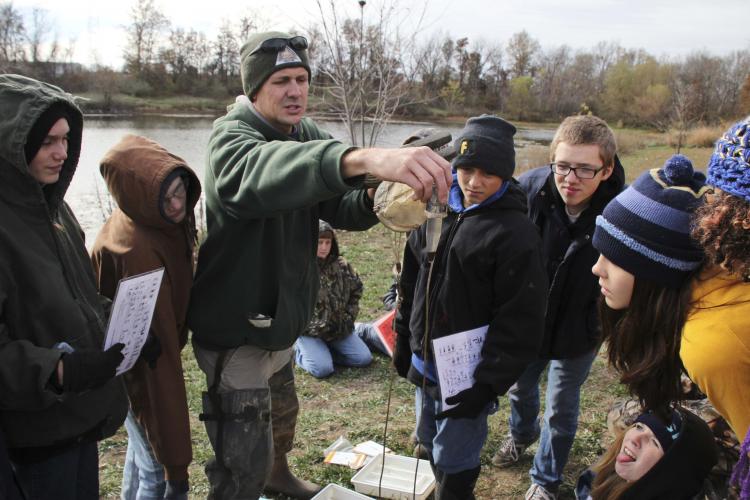
Xplor reconnects kids to nature and helps them find adventure in their own backyard. Free to residents of Missouri.


































Stay in Touch with MDC news, newsletters, events, and manage your subscription

Xplor reconnects kids to nature and helps them find adventure in their own backyard. Free to residents of Missouri.

A monthly publication about conservation in Missouri. Started in 1938, the printed magazine is free to residents of Missouri.




Plattsburg, Mo. -- Water barely rippled on a pond as eighth-grade students unpacked nets and water quality sampling gear. The pond seemed simple at first glance. But that was before they took pH readings, dissolved oxygen samples and scraped the bottom with nets to see what kind of insect larvae survive in a watery ecosystem where humans cannot.
Hamilton Middle School offered an aquatic ecosystem class for the first time this fall as a Discover Nature Schools program in partnership with the Missouri Department of Conservation (MDC). A combination of classroom study and field experience gives the students a deeper look into ecosystems and what keeps them healthy. The Hamilton students recently visited ponds at MDC's Hartell Conservation Area to apply some classroom lessons to a familiar setting, a rural pond. Some have sampled ponds with a fishing rod, but a biological outlook added a new dimension.
“I like the experiments and stuff, it’s kind of different,” said student Brock Swindler, who fishes and hunts. “You have to know all about the habitats and the environment that the animals and fish use, so the class if fun.”
A $1,000 grant from MDC helped the school obtain startup equipment for this Discover Nature Schools (DNS) class program. The money is used to buy scientific testing kits to measure water quality and long-handled dip nets to sample the shallows for critters such as insects, frogs and small fish – all life that feeds the big fish. Grants from $500 to $1,000 are available for the various DNS programs.
Adam Brandsgaard, an MDC education consultant based in Chillicothe, helped the school obtain the grant. On this recent field experience, he also helped teach students how the web of life from sun to plants to animals works in water as well as on land. Brandsgaard used a special net to obtain a water sample for a tube and he held it up for the students to see.
“You see those tiny things moving around,” he said, “those are zooplankton. Zooplankton eat tiny plants.”
Sunlight fuels photosynthesis in single-cell plants, zooplankton eat them, small fish and invertebrates (insects) eat the zooplankton, big fish eat the small fish. That’s what leads to an angler landing a hefty largemouth bass. But good water quality is important for the ecosystem to be productive, Brandsgaard said.
“You’ve got all these creatures that eat each other,” he said. “It’s a big humongous food chain.”
Discover Nature Schools offers a broad range of programs to schools for various age and grade levels. Several ecology and conservation topics are offered and they are designed to match up with state science standards for classroom instruction.
“I like the fact that you can use this material in the science class that you’re already teaching,” said Terri Moore, who teaches what Hamilton Middle School calls the Conservation Class. “It’s also a hands-on experience for the students and it offers in-depth instruction about aquatic ecosystems.”
The grants for text books, a teacher study guide and scientific or field experience gear is made by MDC to classrooms on a one-time basis. But annual grants are available from MDC to pay for fuel costs for field trips to outdoor settings.
The Hamilton students visiting Hartell Conservation Area topped off their field trip with canoeing and fishing, trying out their place at the top of the aquatic food chain and adding fun to the learning.
“When the students get into the program,” Moore said, “they are well engaged into the material.”
For more information, visit mdc.mo.gov and search Discover Nature Schools, or contact your local MDC regional office.